Gesture Drawing
. . . Capturing the Feeling of Movement
All gesture drawing is done quickly. You have to feel the action of your model. You’re letting the pencil roam freely and quickly in order to capture the model’s movement.
The important thing here is not what the final drawing looks like, but that the line is moving in the same way that the model is moving.
The drawing may be meaningless to someone else but it’s important to you because at that moment you’re capturing the feeling of the figure's movement.
Do not look at the paper…keep your eye on the model as he or she moves….. Once again, imagine that you eye is pulling your pencil across the paper.
Use cheap paper (like newsprint) because you’ll go through a lot of it.
Most of the drawings that you will see on this site were done years ago when I was in University. They were done on cheap newsprint and as you can see, some of the paper has stained or yellowed over the years.
Gesture Drawing - The Human Figure Drawing
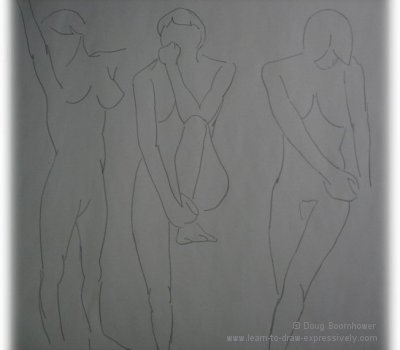
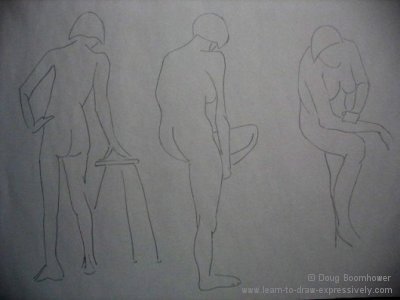
In the above examples, our model changed positions every minute. Our concern as art students, was to capture each pose.
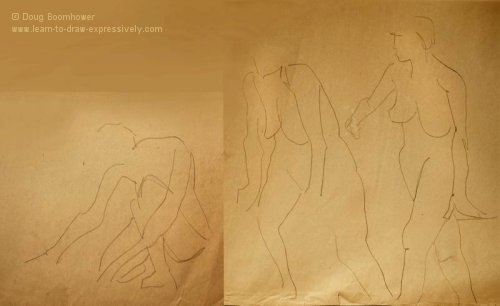
In the above example, the model kept moving. She slowly moved to a crouching position. The artist's responsibility is to capture that sequence of movement. I emphasize that the concern is not to create "pretty" drawings, but rather to capture the feeling of movement. This of course has to be done very quickly.
If you're lucky enough to be enrolled in an art class you will have access to models. (It doesn't matter whether they are clothed or unclothed.)
Anywhere that you can see people in movement are good places to sit and draw because the people don't have to pose...they don't even have to be aware that you are drawing them. Libraries, schools, coffee shops, senior citizens' homes, schoolyards...are good places to give you the invaluable experience of capturing movement.
Pen and Ink Sketches
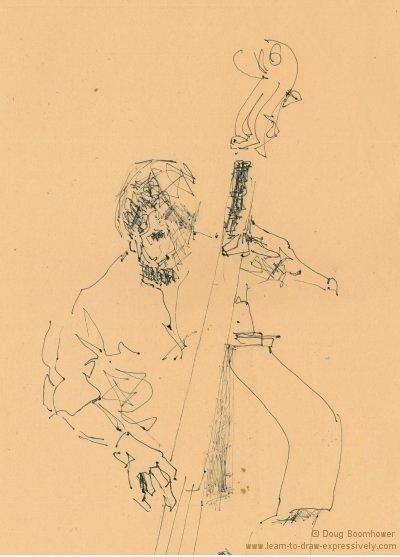
The speed with which this gesture drawing was done conveys the overall pose of the bass player.
Once again, remember its the process, not the final product, that is important.
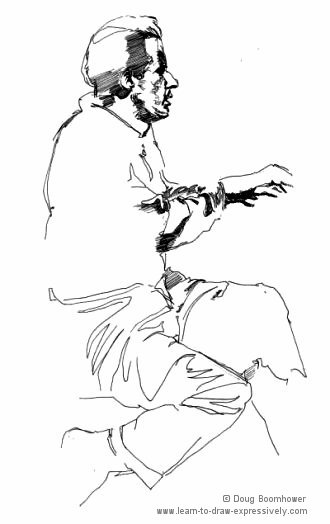
My concern here was to capture a pianist in action...or to "freeze a moment in time". I've slowed down a bit in some areas for very slight detail.
Notice how simply, yet realistically I've captured the movement of his hands and the bulk of his sleeves. A few quickly placed shadows are what account for this realism.
Any areas where I've slowed down even a little bit, we must consider to be called contour rather than gesture lines.
Remember contour lines are slow studies of your model... you must imagine that your pencil is touching your model exactly the same way that the eye is touching the model...then you simply imagine that your eye is pulling the pencil across the paper.
Gesture lines on the other hand, are done very quickly, (as in the torso and the legs). The concern here is not what this drawing will look like, but rather that this drawing exercise will convey a feeling of movement.
This drawing was done in ink.
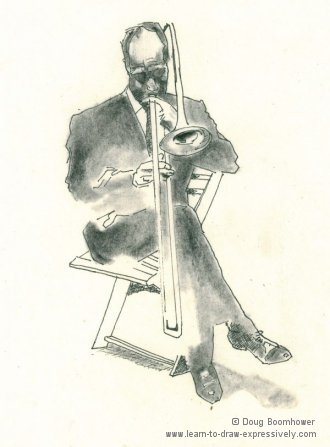
I consider this drawing to be a cross between a gesture drawing and a contour drawing. The entire thing was done quickly.
The difference between it and the previous gesture nude drawings is that this was done in a little less than five minutes.
Notice I retained that same spontaneity I learned by doing so many quick gesture drawings.
This drawing was done in black ink. I also used an ink wash applied with a watercolor brush. (Ink wash is ink diluted in water.)
It's important that you draw quickly while you are learning... this is when you will acquire the feeling of spontaneity that you will carry with you to create good future drawings.
Spontaneity is what gesture drawing is all about!
Return from Gesture Drawing to Home Page




